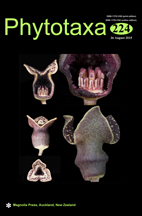Abstract
The new species Eutrema racemosum is described, and its relationship to the closely related E. heterophyllum and E. edwardsii are discussed based on morphological, cytological, and molecular data. The novelty differs from E. heterophyllum by having elongated racemes and from E. edwardsii by somewhat reflexed fruiting pedicels. Four chloroplast DNA fragments and nuclear ITS region were sequenced for multiple individuals of each species. Three species show distinct and stable sequence variations. Eutrema racemosum and E. heterophyllum form a clade sister to that of E. edwardsii in phylogenetic analyses of sequence variations. Our cytological studies revealed that E. heterophyllum is a diploid with the small genome size, while E. racemosum is a tetraploid with duplicate genomes. These available data support the recognition of E. racemosum as a distinct species well differentiated morphologically and genetically, as well as well-isolated reproductively from its sister species E. heterophyllum. We further found some interspecific triploid hybrids between tetraploid E. racemosum and diploid E. heterophyllum, which seem to be sterile according to our germination experiments.

